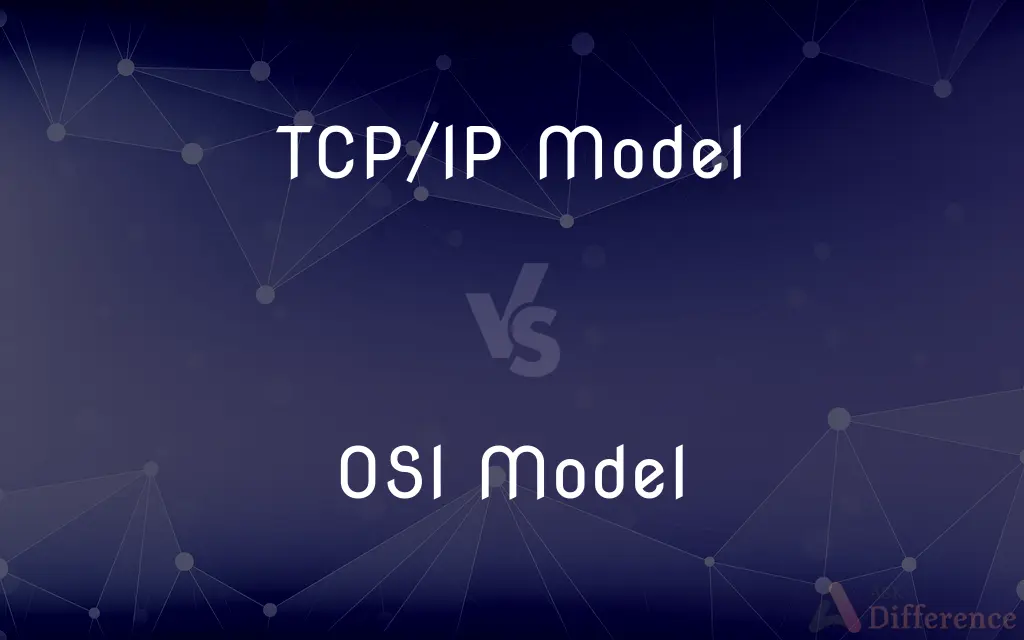TCP/IP Model vs. OSI Model — What's the Difference?
By Tayyaba Rehman — Published on January 11, 2024
The TCP/IP Model is a practical framework for internet communication, while the OSI Model is a theoretical 7-layer model for understanding network interactions.

Difference Between TCP/IP Model and OSI Model
Table of Contents
ADVERTISEMENT
Key Differences
The TCP/IP Model and the OSI Model are conceptual models used to understand and implement computer networking protocols. The TCP/IP Model, also known as the Internet Protocol Suite, is a more simplified and pragmatic model used in the real-world implementation of networks. It consists of four layers: Network Interface, Internet, Transport, and Application. The OSI Model, on the other hand, is a theoretical framework for understanding network interactions and comprises seven layers: Physical, Data Link, Network, Transport, Session, Presentation, and Application.
Each layer in the TCP/IP Model covers a range of functions that are distributed among the seven layers of the OSI Model. For instance, the Application layer in the TCP/IP model encompasses the functionalities of the Application, Presentation, and Session layers of the OSI Model. This makes the TCP/IP Model more straightforward but less detailed compared to the OSI Model.
The TCP/IP Model was developed and refined in the early stages of the Internet and is closely aligned with the standard protocols used in networking like TCP and IP. The OSI Model, created by the International Organization for Standardization (ISO), is more of a theoretical tool designed to understand and standardize the process of networking systems.
In practical applications, the TCP/IP Model is widely used and forms the basis of the internet and most networking systems. The OSI Model is more commonly used in academic and educational contexts to teach the concepts of networking and communication protocols.
The TCP/IP Model is known for its simplicity and effectiveness in practical implementation, while the OSI Model is appreciated for its comprehensive and detailed approach to understanding how networks function.
ADVERTISEMENT
Comparison Chart
Number of Layers
4 layers
7 layers
Layers
Network Interface, Internet, Transport, Application
Physical, Data Link, Network, Transport, Session, Presentation, Application
Purpose
Practical implementation of internet communication
Theoretical framework for understanding network interactions
Usage in Practice
Widely used in real-world networking
Mainly used for educational and theoretical understanding
Complexity
More simplified and pragmatic
More detailed and comprehensive
Compare with Definitions
TCP/IP Model
TCP/IP Model is a four-layer framework for internet protocols and communication.
The Internet Protocol (IP) in the TCP/IP Model is crucial for routing data packets.
OSI Model
OSI Model is used more for education and theoretical understanding.
Networking students study the OSI Model to understand the fundamentals of network layers.
TCP/IP Model
Focuses on standard protocols like TCP and IP for networking.
The Transport layer in the TCP/IP Model manages the transmission control protocol (TCP).
OSI Model
It standardizes the network communication process for diverse systems.
The OSI Model helps in ensuring interoperability between different network devices.
TCP/IP Model
It's the primary model for understanding and implementing internet networking.
Internet service providers use the TCP/IP Model to design and manage their networks.
OSI Model
It provides a comprehensive approach to understanding network interactions.
Network engineers use the OSI Model to troubleshoot connection issues.
TCP/IP Model
It's known for its simplicity in describing network protocols.
The TCP/IP Model simplifies the process of secure data transmission.
OSI Model
Each layer in the OSI Model represents a distinct function in networking.
Data encryption and decryption are part of the Presentation layer in the OSI Model.
TCP/IP Model
TCP/IP Model covers basic to complex network functionalities.
Email transmission over the internet relies on the TCP/IP Model.
OSI Model
OSI Model is a theoretical 7-layer model for network communication.
The OSI Model's Physical layer deals with the hardware aspects of networking.
Common Curiosities
What is the TCP/IP Model?
It's a practical, four-layer framework for internet communication.
What is the OSI Model?
The OSI Model is a theoretical, seven-layer framework for network interaction.
Is the TCP/IP Model used in real-world networking?
Yes, it's the primary model used in internet networking.
What are the layers of the OSI Model?
The OSI Model has seven layers: Physical, Data Link, Network, Transport, Session, Presentation, and Application.
What is the main purpose of the OSI Model?
To provide a comprehensive framework for understanding and standardizing network interactions.
Which model is more complex, TCP/IP or OSI?
The OSI Model is more complex with seven detailed layers.
How many layers does the TCP/IP Model have?
The TCP/IP Model has four layers.
Do network professionals use the OSI Model?
They use it mainly for theoretical understanding and education.
Is the TCP/IP Model simpler than the OSI Model?
Yes, the TCP/IP Model is simpler with fewer layers.
Can the OSI Model be used for practical implementation?
It's mainly theoretical and used for education, not for practical implementation.
What is the importance of the TCP/IP Model in the internet?
It forms the basis of internet communication and protocol implementation.
Are the OSI and TCP/IP models compatible?
They are conceptually compatible but differ in structure and detail.
How does the OSI Model help in networking?
It helps in understanding and troubleshooting network issues by segmenting network communication into distinct layers.
Which model is older, TCP/IP or OSI?
The TCP/IP Model was developed earlier than the OSI Model.
Can the OSI Model be applied to internet protocols?
It can be used to understand internet protocols but is not directly applied in their implementation.
Share Your Discovery

Previous Comparison
Adobe Photoshop vs. CorelDRAW
Next Comparison
Star Topology vs. Mesh TopologyAuthor Spotlight
Written by
Tayyaba RehmanTayyaba Rehman is a distinguished writer, currently serving as a primary contributor to askdifference.com. As a researcher in semantics and etymology, Tayyaba's passion for the complexity of languages and their distinctions has found a perfect home on the platform. Tayyaba delves into the intricacies of language, distinguishing between commonly confused words and phrases, thereby providing clarity for readers worldwide.
















































